
false
Flamborough Cliffs Nature Reserve
Enjoy peaceful cliff top views and seawatching throughout the year.
Location
Know before you go
Dogs
Please pick up after your dog and use a bin.
When to visit
Opening times
Open at all timesBest time to visit
March to JulyAbout the reserve
Stunning sea views and excellent views of nesting puffins can be seen from the cliff tops from mid May to mid July. (Be sure to join us at our annual Yorkshire Puffin Festival every May/June.) Look out too for fulmar, kittiwake, guillemots and razorbills. It's a great place for bird and sea-watching during spring and autumn migrations.
Habitat
Contact us

puffin - Adam Jones
Yorkshire's puffins
Beautifully decorated with its multicoloured beak, heavy eyeshadow and distinguished black and white suit, the puffin is easily Yorkshire’s most iconic and charismatic seabird. If you’ve ever seen one, you’ll know it’s hard not to fall for these clifftop characters.
Nearby

Puffin - (C) Jim Highman
Help create a Yorkshire rich in wildlife
Yorkshire is home to magical wildlife and wild places. It’s undeniably special, but it’s also under serious threat.
Nature can't act to stop and reverse these trends - but together we can!
Will you join Yorkshire Wildlife Trust and make a real and lasting difference?








